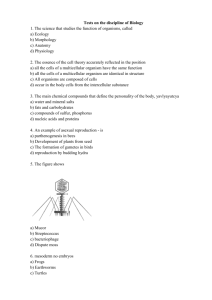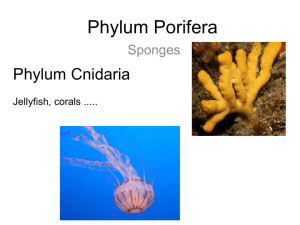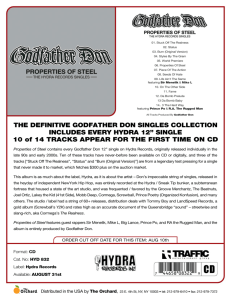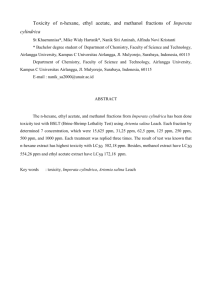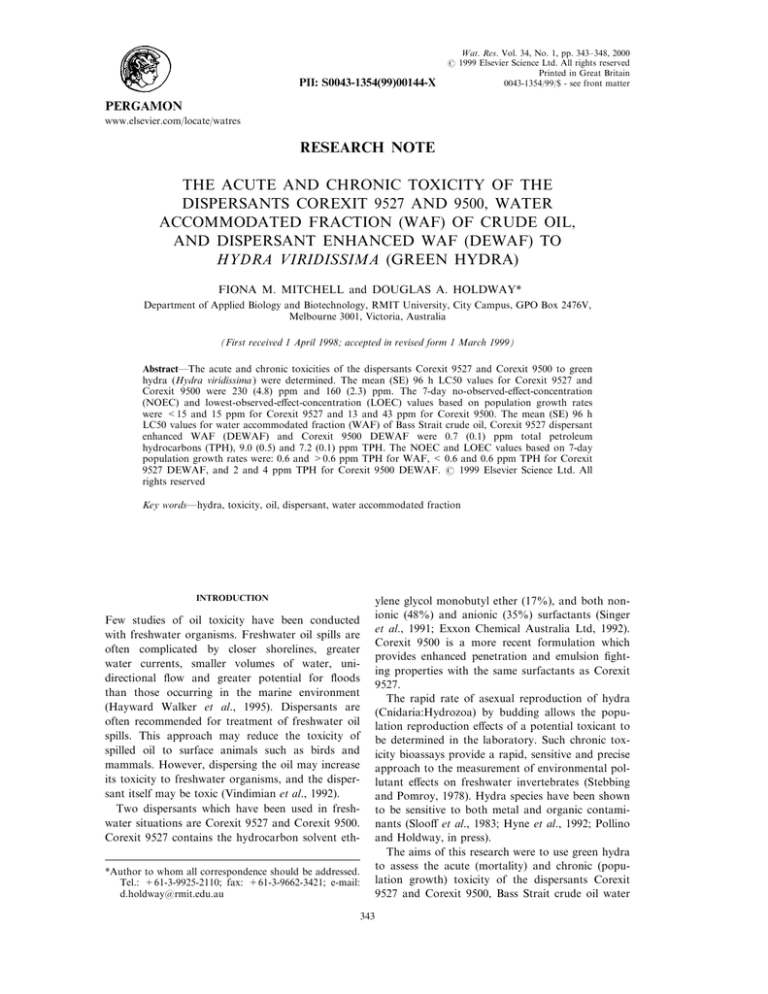
PII: S0043-1354(99)00144-X
Wat. Res. Vol. 34, No. 1, pp. 343±348, 2000
# 1999 Elsevier Science Ltd. All rights reserved
Printed in Great Britain
0043-1354/99/$ - see front matter
www.elsevier.com/locate/watres
RESEARCH NOTE
THE ACUTE AND CHRONIC TOXICITY OF THE
DISPERSANTS COREXIT 9527 AND 9500, WATER
ACCOMMODATED FRACTION (WAF) OF CRUDE OIL,
AND DISPERSANT ENHANCED WAF (DEWAF) TO
HYDRA VIRIDISSIMA (GREEN HYDRA)
FIONA M. MITCHELL and DOUGLAS A. HOLDWAY*
Department of Applied Biology and Biotechnology, RMIT University, City Campus, GPO Box 2476V,
Melbourne 3001, Victoria, Australia
(First received 1 April 1998; accepted in revised form 1 March 1999)
AbstractÐThe acute and chronic toxicities of the dispersants Corexit 9527 and Corexit 9500 to green
hydra (Hydra viridissima ) were determined. The mean (SE) 96 h LC50 values for Corexit 9527 and
Corexit 9500 were 230 (4.8) ppm and 160 (2.3) ppm. The 7-day no-observed-eect-concentration
(NOEC) and lowest-observed-eect-concentration (LOEC) values based on population growth rates
were <15 and 15 ppm for Corexit 9527 and 13 and 43 ppm for Corexit 9500. The mean (SE) 96 h
LC50 values for water accommodated fraction (WAF) of Bass Strait crude oil, Corexit 9527 dispersant
enhanced WAF (DEWAF) and Corexit 9500 DEWAF were 0.7 (0.1) ppm total petroleum
hydrocarbons (TPH), 9.0 (0.5) and 7.2 (0.1) ppm TPH. The NOEC and LOEC values based on 7-day
population growth rates were: 0.6 and >0.6 ppm TPH for WAF, < 0.6 and 0.6 ppm TPH for Corexit
9527 DEWAF, and 2 and 4 ppm TPH for Corexit 9500 DEWAF. # 1999 Elsevier Science Ltd. All
rights reserved
Key wordsÐhydra, toxicity, oil, dispersant, water accommodated fraction
INTRODUCTION
Few studies of oil toxicity have been conducted
with freshwater organisms. Freshwater oil spills are
often complicated by closer shorelines, greater
water currents, smaller volumes of water, unidirectional ¯ow and greater potential for ¯oods
than those occurring in the marine environment
(Hayward Walker et al., 1995). Dispersants are
often recommended for treatment of freshwater oil
spills. This approach may reduce the toxicity of
spilled oil to surface animals such as birds and
mammals. However, dispersing the oil may increase
its toxicity to freshwater organisms, and the dispersant itself may be toxic (Vindimian et al., 1992).
Two dispersants which have been used in freshwater situations are Corexit 9527 and Corexit 9500.
Corexit 9527 contains the hydrocarbon solvent eth*Author to whom all correspondence should be addressed.
Tel.: +61-3-9925-2110; fax: +61-3-9662-3421; e-mail:
d.holdway@rmit.edu.au
343
ylene glycol monobutyl ether (17%), and both nonionic (48%) and anionic (35%) surfactants (Singer
et al., 1991; Exxon Chemical Australia Ltd, 1992).
Corexit 9500 is a more recent formulation which
provides enhanced penetration and emulsion ®ghting properties with the same surfactants as Corexit
9527.
The rapid rate of asexual reproduction of hydra
(Cnidaria:Hydrozoa) by budding allows the population reproduction eects of a potential toxicant to
be determined in the laboratory. Such chronic toxicity bioassays provide a rapid, sensitive and precise
approach to the measurement of environmental pollutant eects on freshwater invertebrates (Stebbing
and Pomroy, 1978). Hydra species have been shown
to be sensitive to both metal and organic contaminants (Sloo et al., 1983; Hyne et al., 1992; Pollino
and Holdway, in press).
The aims of this research were to use green hydra
to assess the acute (mortality) and chronic (population growth) toxicity of the dispersants Corexit
9527 and Corexit 9500, Bass Strait crude oil water
344
Research Note
accommodated fraction (WAF), and mixtures of
dispersant and crude oil WAF (Dispersant
Enhanced WAF). The reference toxicant 4-chlorophenol was used to determine changes in the sensitivity of hydra over time (Environment Canada,
1990).
MATERIALS AND METHODS
Culture maintenance
Green hydra (H. viridissima ) stock cultures were maintained in one litre glass bowls ®lled with autoclaved carbon-®ltered mains water and located in a 258C constant
temperature room with 12-h light:dark photoperiod.
Excess newly hatched Artemia salina nauplii (brine shrimp)
were fed to hydra daily. Water was replaced after 30 min,
and hydra were placed in clean bowls weekly.
Experimental design
Methods for acute toxicity testing were based on the
Standard Guide for Conducting Acute Toxicity Tests with
Fishes, Macroinvertebrates, and Amphibians (E729-88a)
(American Society for Testing and Materials, 1996).
Chronic toxicity testing methods were based on the Hydra
Test protocol of the Supervising Scientist Report (110)
(Hyne et al., 1996). Temperature, pH, dissolved oxygen
and total hardness were measured for each test.
Acute toxicity tests
Twenty non-budding hydra were randomly assigned to
glass Petri dishes and positioned randomly under the light.
Concentrations were based on the results of range ®nder
tests. The number of hydra in each Petri dish were
counted at 0, 1, 2, 4, 8, 12, 24, 36, 48, 72 and 96 h. Hydra
were not fed during the acute tests. During all tests hydra
with unseparated buds were recorded, but counted as one
hydra. The lethal toxicity end-points were the tulip and
disintegrated stages. Each acute toxicity test series was
performed four times using freshly prepared stock solutions.
Reference toxicant
4-Chlorophenol (Sigma, 99+% purity) tests were static
because of the highly stable nature in solution
(Environment Canada, 1990). Test solution samples were
taken at 0 and 96 hours for concentration analysis using
the `Direct Photometric Method for Phenols' in the
Standard Methods for the Examination of Water and
Wastewater (Greenberg et al., 1992). Measured concentrations ranged from 0 to 80 (1.5) ppm 4-chlorophenol. A
concentration close to the calculated LC50 for 4-chlorophenol (36 ppm) was run simultaneously with all other
toxicity tests to determine if there was change in green
hydra sensitivity over time.
Chronic toxicity tests
Each experiment was simultaneously replicated four
times at a range of concentrations based on range ®nder
tests. Five budding hydra were randomly assigned to each
Petri dish, and the number of hydra were counted at 24 h,
then daily for a total of 7 days. Hydra were fed to excess
daily with 500 ml of live brine shrimp in test solution.
After 30 min, test solutions were replaced. Water samples
were collected on days 0, 4 and 7 for chemical analysis.
concentrations ranged from 0 to 320 (3.8) ppm Corexit
9527 and 0 to 170 (7.2) ppm Corexit 9500. Test solutions
for concentration analysis were collected at 0 and 24 h,
before and after solution replacement. Samples were
measured at 230 nm in a UV-VIS spectrophotometer
(Hitachi U2000).
WAF of crude oil
Crude oil and carbon-®ltered mains water were mixed
at a ratio of 1:9 (750 ml:6.75 l) in a 10-l glass mixing
chamber (Fucik et al. 1995). The contents were mixed for
23 h in the dark with 1 h for settling. The aqueous layer
(WAF) was used as the stock solution. Measured concentrations ranged from 0 to 1 ppm TPH for acute toxicity
tests, and 0 to 0.6 ppm TPH for chronic tests. A 200-ml
sample of WAF stock solution was extracted in hexane.
GC analyses measured polycyclic aromatic hydrocarbons
(PAH) and total petroleum hydrocarbons (TPH).
A time dependent toxicity test was performed to further
observe hydra population growth rates. Five hydra were
randomly placed in Petri dishes containing 1 ppm TPH
for 0, 5, 10, 24, 30, 48 and 72 h and fed daily. After the
appropriate time, hydra were pipetted into a Petri dish
with carbon-®ltered mains water until day 7. The controls
were also placed in carbon-®ltered mains water after 24 h.
A 200-ml sample of WAF stock solution was extracted
in hexane, and total polycyclic aromatic hydrocarbons
(PAH) and petroleum hydrocarbons (TPH) were measured
by GC.
Corexit 9527 dispersant enhanced WAF (DEWAF) and
Corexit 9500 DEWAF
WAF was prepared as previously described. Dispersant
was mixed with crude oil collected from the top of the
WAF mixing chamber at a ratio of 1:29 (3.45 ml:100 ml)
as recommended by Exxon Chemical Australia Ltd (1992).
This solution was mixed by hand for approximately 2 min,
then 1 ml of this dispersant/oil solution was added to 1 l
of WAF in a glass mixing bottle and mixed on a magnetic
stirrer for 20 minutes. The aqueous layer was used as the
stock solution. Measured concentrations for acute toxicity
tests ranged from 0 to 20 ppm TPH for Corexit 9527
DEWAF and 0 to 10 ppm TPH for Corexit 9500
DEWAF. Measured concentrations for chronic toxicity
tests ranged from 0 to10 ppm TPH for Corexit 9527
DEWAF and 0 to 9 ppm TPH for Corexit 9500 DEWAF.
The stock solution was analysed for PAH and TPH as
described for WAF.
Analysis of results
The trimmed Spearman-Karber method (Hamilton et
al., 1977) was used to calculate the 96 h LC50 values. Ttests were performed to detect signi®cance between LC50
values within species.
For chronic toxicity tests, a one way analysis of variance (ANOVA) was used to determine if there was signi®cant dierence between the number of hydra on day 7 and
the mean population growth rate (K ) for dierent treatments. If the treatments were signi®cant (P R 0.05), the
Fisher's Least Signi®cant Dierence test (P R 0.05) determined which concentrations were signi®cant. The mean
population growth rate (K ) on day 7 was calculated for
all chronic toxicity tests. The mean population growth
rate is de®ned as:
K
number of hydra=day
ln
ny ÿ ln
nx
ty±tx
Corexit 9527 and Corexit 9500
Mean (SE) measured concentrations for acute tests ranged from 0 to 280 (8.0) ppm Corexit 9527 and 0 to 450
(19.6) ppm Corexit 9500. Mean (SE) chronic test measured
where ny is the number of hydra on the ®nal day, nx is
the number of hydra on day 0 and ty±tx is the length of
the experiment, in days.
Research Note
345
Table 1. Mean (SE) 96 h LC50 values and 7-day population growth rate NOEC and LOEC values for green hydra (n = 4 for all toxicants) Values within LC50 column without a superscript in common are signi®cantly dierent (P R 0.05)
Toxicant
LC50
NOEC
LOEC
4-chlorophenol (ppm)
Corexit 9527 (ppm)
Corexit 9500 (ppm)
WAF (ppm TPH)
Corexit 9527 DEWAF (ppm TPH)
Corexit 9500 DEWAF (ppm TPH)
34 (2.2)d
230 (4.8)f
160 (2.3)e
0.7 (0.1)a
9.0 (0.5)c
7.2 (0.1)b
±
< 15
13
0.6
< 0.6
2
±
RESULTS
Water characteristics
The range for pH was from 6.5 to 7.6, temperature 24.4 to 25.38C, dissolved oxygen 8.3 to 8.8
ppm. All measurements including total water hardness did not vary signi®cantly between experiments.
Reference toxicant
Green hydra exposed to 4-chlorophenol had a
mean 96 h LC50 of 34 ppm (Table 1). Sensitivity to
the reference toxicant did not dier signi®cantly
over the testing period (range 42±61% mortality).
Corexit 9527 and Corexit 9500
Corexit 9500 was more acutely toxic to green
hydra than Corexit 9527 (Table 1). The mean population growth rates (K ) of green hydra were
reduced after 7 days of exposure, with Corexit 9500
being the more toxic dispersant (Fig. 1a).
WAF of crude oil
The WAF stock solution contained measured
concentrations of 50 ppb PAH and 1ppm TPH.
WAF was highly toxic to green hydra in the short
term (Table 1). Hydra growth rate did not decrease
after chronic exposure to WAF concentrations
tested. Population growth increased at the lower
concentrations of WAF compared to the controls
(Fig 1b). Time dependent toxicity testing using 1
ppm TPH for 5±48 h showed a signi®cant increase
in hydra growth rate, and exposure for 72 h caused
a signi®cant decrease in hydra growth rate compared to the controls (Fig. 2).
Corexit 9527 DEWAF and Corexit 9500 DEWAF
The stock solutions contained measured concentrations of 100 ppb PAH and 20 ppm TPH for
Corexit 9527 DEWAF, and 80 ppb PAH and 100
ppm TPH for Corexit 9500 DEWAF. Corexit 9500
DEWAF was more acutely toxic than Corexit 9527
DEWAF (Table 1). Corexit 9500 DEWAF reduced
population growth rates at lower TPH concentrations than Corexit 9527 DEWAF (Fig. 1c).
DISCUSSION
The 4-chlorophenol 96 h LC50 of 34 ppm for
green hydra in this study is comparable to the 96 h
LC50 of 45 ppm previously reported for this lab-
15
43
> 0.6
0.6
4
oratory by Pollino and Holdway (in press). Hydra
are less sensitive to acute 4-chlorophenol exposure
than other test species, such as Daphnia magna with
a 48 h LC50 of 6.5 ppm (Kuiper and Hanstveit,
1984).
It is unlikely green hydra will be aected by concentrations of dispersant used during oil spill treatment. Green hydra appear to be less sensitive to
dispersants than other freshwater species, having a
96 h LC50 for Corexit 9527 of 230 ppm. This value
is higher than D. magna, whose 96 h LC50 has
been variably reported as 72.5 ppm (Shales, 1989,
unpublished data) and 25 ppm (Brown and
Goodman, 1989).
Previous researchers have used a variety of
methods to assess the acute and chronic toxicity of
crude oil WAF by preparing various water and oil
combinations. This makes comparisons between
animal species and oil types dicult. For example,
Anderson et al. (1974) reported 96 h LC50 values
for the brown shrimp (Penaeus aztecus ) and grass
shrimp (P. pugio ) and 48 h LC50 values for the
mysid (Mysidopsis almyra ) for South Louisiana and
Kuwait crude oils as greater than 6 ppm TPH in all
cases. In comparison, exposure of green hydra to
Bass Strait crude oil (WAF) showed greater sensitivity, with a 96 h LC50 of 0.7 ppm TPH.
Hydra growth rate increased after seven days of
exposure to 0.1 and 0.3 ppm TPH of Bass Strait
WAF compared to the controls. This increase in
budding rate has been termed hormesis. Hormesis is
an overcorrection of biosynthetic control mechanisms following exposure to low levels of contaminants, resulting in growth that is greater than
normal (Stebbing, 1982). Hormesis has been
observed previously in hydra exposed to low concentrations of lead (Browne and Davis, 1977) and
copper (Pollino and Holdway, in press). Hormesis
was also apparent after exposure of hydra to 1 ppm
TPH for 48 hours or less. However, exposure of
hydra to 1 ppm TPH for 72 hours caused the
growth rate to fall below that of the control group.
Crude oil spilled into freshwater can be from
burst pipelines or transport accidents. Aquatic
organisms would be pulse-exposed to high concentrations of the product for a short period before
spreading, evaporation, dissolution, and emulsi®cation (Hayward Walker et al., 1995). Continuous ex-
346
Research Note
Fig. 1. Mean (SE) population growth rate of green hydra (number of hydra per day) after 7 days'
exposure to (a) Corexit 9527 and Corexit 9500; (b) WAF; (c) Corexit 9527 DEWAF and Corexit 9500
DEWAF.
Research Note
347
Fig. 2. Mean (SE) population 7 day growth rate of green hydra (number of hydra per day) after exposure to 1 ppm TPH for 0±3 days.
posure to WAF of crude oil for 96 h may therefore
overestimate exposure.
Corexit 9500 DEWAF may have been more toxic
to green hydra than Corexit 9527 DEWAF due to
either the increased toxicity of the dispersant alone,
or the toxic components of Bass Strait crude being
more readily available to the hydra. By contrast,
the chronic toxicity of Corexit 9527 DEWAF was
greater than that of Corexit 9500 DEWAF. Perhaps
Corexit 9527 DEWAF speci®cally aects budding
processes.
The WAF of Bass Strait crude oil was more
acutely toxic to green hydra than when tested in
combination with either dispersant. The toxic components of the WAF may have been more readily
available to hydra, either by ingestion or direct
uptake. Both DEWAF stock solutions contained
higher concentrations of both PAH and TPH; however, these components may not have been as
readily available to the hydra.
WAF and DEWAF concentrations were near
those expected in the environment following an oil
spill, indicating that green hydra populations may
be vulnerable to such events. It is unlikely that
freshwater organisms in the environment would be
continuously exposed to dispersants, WAF or
DEWAF for the duration of toxicity tests conducted in the laboratory.
AcknowledgementsÐThanks to Nalco/Exxon Energy
Chemicals for the supply of the dispersants Corexit 9527,
Corexit 9500 and Bass Strait crude oil, and to the
Toxicology Key Centre at RMIT for the use of their facilities. FMM gratefully acknowledges receipt of an RMIT
Faculty of Biomedical and Health Sciences and Nursing
write-up award.
REFERENCES
American Society for Testing Materials (1996) Standard
guide for conducting acute toxicity tests with ®shes,
macroinvertebrates, and amphibians, E729-88a, 11.05,
249±269. American Society for Testing and Materials,
Philadelphia, PA.
Anderson J. W., Ne J. M., Cox B. A., Tatem H. E. and
Hightower G. M. (1974) Characteristics of dispersion
and water-soluble extracts of crude and re®ned oils and
their toxicity to estuarine crustaceans and ®sh. Marine
Biology 27, 75±88.
Browne C. L. and Davis L. E. (1977) Cellular mechanisms
of stimulation of bud production in Hydra by low levels
of inorganic lead compounds. Cell Tissue Research 177,
555±570.
Brown H. M. and Goodman R. H. (1989) Dispersants in
the freshwater environment. In Oil Dispersants: New
Ecological Approaches, ASTM STP 1018, ed. M.
Flaherty, pp. 31±40. American Society for Testing and
Materials, Philadelphia.
Environment Canada (1990) Guidance document on control
of toxicity test precision using reference toxicants,
Report EPS 1/RM/12. Minister of Supply & Services,
Canada, 69 pp.
Exxon Chemical Australia Ltd (1992) Material Safety
Data SheetÐCorexit 9527. Melbourne. Victoria, 4 pp.
Fucik K. W., Carr K. A. and Balcom B. J. (1995) Toxicity
of oil and dispersed oil to the eggs and larvae of seven
marine ®sh and invertebrates from the Gulf of Mexico.
In The Use of Chemicals in Oil Spill Response, ASTM
STP 1252, ed. P. Lane, pp. 135±171. American Society
for Testing and Materials, Philadelphia.
Greenberg A. E., Clesceri L. S. and Eaton A. D. (eds.)
(1992) 5530 Phenols. In Standard Methods for the
Examination of Water and Wastewater, 18th ed., 5-24±529. American Public Health Association, American
Water Works Association and Water Environment
Federation, USA.
Hamilton M. A., Russo R. C. and Thurston R. V. (1977)
Trimmed Spearman-Karber method for estimating median lethal concentrations in toxicity bioassays.
Environmental Science and Technology 11, 714±719.
Hayward Walker A., Kucklick J. H., Steen A. E. and
Fritz D. (1995) Oil spill chemicals in freshwater environments: Technical issues. In Proceedings of the 1995
International Oil Spill Conference, American Petroleum
Institute, Washington, pp. 373±379.
Hyne R. V., Rippon G. D. and Ellender G. (1992) pHDependent uranium toxicity to freshwater hydra. The
Science of the Total Environment 125, 159±173.
Hyne R. V., Rippon G. D., Hunt S. M. and Brown G. H.
(1996) Hydra population growth test (Hydra viridissima
and Hydra vulgaris ). In Procedures for the Biological
Toxicity Testing of Mine Waste Waters Using
348
Research Note
Freshwater Organisms. Supervising Scientist Report
(110, 4 BTT-B) Environmental Research Institute of the
Supervising Scientist, Jabiru, Northern Territory,
Commonwealth of Australia, pp. 23±33.
Kuiper J. and Hanstveit A. O. (1984) Fate and eects of
4-chlorophenol and 2,4-dichlorophenol in marine plankton
communities
in
experimental
enclosures.
Ecotoxicology and Environmental Safety 8, 15±33.
Pollino C. A. and Holdway D. A. (1999) (in press) The
potential of hydra species as standard toxicity test animals. Ecotoxicology and Environmental Safety 43.
Shales S. (1989) Biological and ecological eects of oil. In
The Fate and Eects of Oil in Freshwater, eds J. Green
and M. W. Trett, pp. 103±172. Elsevier Applied Science,
London.
Singer M. M., Smalheer D. L., Tjeerdema R. S. and
Martin M. (1991) Eects of spiked exposure to an oil
dispersant on the early life stages of four marine species.
Environmental Toxicology and Chemistry 10, 1367±2374.
Sloo W., Canton J. H. and Hermens J. L. M. (1983)
Comparison of the susceptibility of 22 freshwater species
to 15 chemical compounds. 1. (Sub)acute toxicity tests.
Aquatic Toxicology 4, 113±128.
Stebbing A. R. D. (1982) HormesisÐthe stimulation of
growth by low levels of inhibitors. Science of the Total
Environment 22, 213±234.
Stebbing A. R. D. and Pomroy A. J. (1978) A sublethal
technique for assessing the eects of contaminants using
Hydra littoralis. Water Research 12, 631±635.
Vindimian E., Vollat B. and Garric J. (1992) Eect of the
dispersion of oil in freshwater based on time-dependent
Daphnia magna toxicity tests. Bulletin of Environmental
Contamination and Toxicology 48, 209±215.

